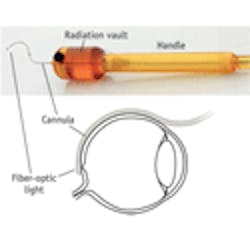OPHTHALMOLOGY/NONINVASIVE TREATMENT: Fiber-optic device promises minimally invasive treatment for wet AMD
Wet age-related macular degeneration (wet AMD) is a major cause of blindness and visual impairment in adults over 50, and currently the only treatment is weekly injection of drugs into the eyeball. But results of a Phase 1 human study show promise that a minimally invasive, fiber-optic-based device by Salutaris Medical Devices could prove effective, providing relief in multiple ways to the many people affected. The handheld, visually guided SalutarisMD, with a probe that slides under the lid to reach its target at the back of the eye, is designed to enable retina specialists to complete the procedure in a clinical environment using local anesthesia in approximately 15 minutes.
During the Retina Meeting 2012 (January 17; Maui, HI), Reid Schindler, MD, reviewed the short-term safety study involving six subjects, and presented the data. Schindler, principal investigator of the study, is a clinical ophthalmologist and retina specialist with Retina Specialists of Southern Arizona, and clinical associate professor at the University of Arizona's Department of Ophthalmology. He said that both persistently treated and newly diagnosed subjects had either classic or occult neovascular lesions. The investigators placed the SalutarisMD device and delivered the brachytherapy dose with ease and minimal subject discomfort. The study reported no serious adverse events, and no unanticipated adverse device effects.
While the study is not intended to be extrapolated for statistical significance, and while follow-up is short, individual subject results were tracked. All study subjects had an improvement in vision as measured by best corrected visual acuity, and none experienced a loss of vision.
More BioOptics World Current Issue Articles
More BioOptics World Archives Issue Articles

